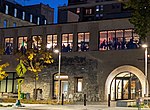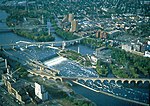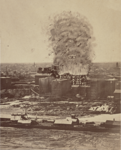Ceresota Building

Northwestern Consolidated Milling Company Elevator A also known as the Ceresota Elevator and "The Million Bushel Elevator" was a receiving and public grain elevator built by the Northwestern Consolidated Milling Company in 1908 in Minneapolis, Minnesota in the United States. The elevator may have been the largest brick elevator ever constructed (brick construction being relatively uncommon) and ran on electricity. The elevator was the source for the Crown Roller Mill and Standard Mill. Those mills closed in the 1950s but the elevator continued in use for grain storage until the mid 1980s. The building is a contributing property of the Saint Anthony Falls History District listed in the National Register of Historic Places in 1971. In 1987 the elevator was converted to 92,081 square feet (8,555 m2) of office space. That required removing the vertical bin structure and creating floors without destroying the building walls. Before the conversion the building was documented to Historic American Engineering Record standards. Conversion was sensitive to the building history and the building is still a contributing property. About 2015 the building was converted to Millers Landing Senior Living.
Excerpt from the Wikipedia article Ceresota Building (License: CC BY-SA 3.0, Authors, Images).Ceresota Building
South 2nd Street, Minneapolis
Geographical coordinates (GPS) Address Nearby Places Show on map
Geographical coordinates (GPS)
| Latitude | Longitude |
|---|---|
| N 44.979722222222 ° | E -93.259722222222 ° |
Address
Metropolitan Lofts
South 2nd Street 545
55415 Minneapolis
Minnesota, United States
Open on Google Maps











